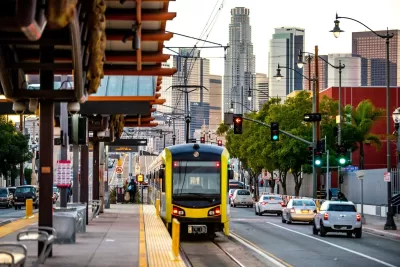Rail and bus ridership in the Los Angeles metropolitan area is recovering at a faster rate than the national average.

L.A. Metro averaged more than 1 million weekday riders for the first time since before the pandemic last month, according to an article from local news outlet KNX News. The milestone marks the 22nd consecutive month of year-over-year ridership growth. The announcement comes as transit ridership has lagged behind pre-pandemic levels in major cities across the country.
The article goes on to report that L.A. Metro’s combined bus and rail ridership reached 86.4 percent of its September 2019 pre-pandemic records, which exceeds the nationwide transit average of 76 percent of pre-pandemic levels. When divided between weekdays and weekends, Metro boardings stood at 83.6 percent and 96.9 percent of September 2019 levels respectively.
One of the driving factors in the sluggish ridership recovery is shifting work patterns (e.g., increase in remote work), as well as service cuts due to funding and staffing challenges. But all modes are not struggling, or recovering equally. According to a April article from Smart Cities Dive, bus transit has recovered faster nationwide, having reached 81 percent of 2019 ridership as of December 2023, while commuter rail has lagged at 65 percent. According to the KNX News article, L.A. Metro is bucking that trend, with commuter rail boardings increasing 10 percent in September 2024 compared to September 2023 versus 6.9 percent for bus boardings.
FULL STORY: Metro reaches milestone of 1M weekday riders

Study: Maui’s Plan to Convert Vacation Rentals to Long-Term Housing Could Cause Nearly $1 Billion Economic Loss
The plan would reduce visitor accommodation by 25,% resulting in 1,900 jobs lost.

Alabama: Trump Terminates Settlements for Black Communities Harmed By Raw Sewage
Trump deemed the landmark civil rights agreement “illegal DEI and environmental justice policy.”

Why Should We Subsidize Public Transportation?
Many public transit agencies face financial stress due to rising costs, declining fare revenue, and declining subsidies. Transit advocates must provide a strong business case for increasing public transit funding.

Paris Bike Boom Leads to Steep Drop in Air Pollution
The French city’s air quality has improved dramatically in the past 20 years, coinciding with a growth in cycling.

Why Housing Costs More to Build in California Than in Texas
Hard costs like labor and materials combined with ‘soft’ costs such as permitting make building in the San Francisco Bay Area almost three times as costly as in Texas cities.

San Diego County Sees a Rise in Urban Coyotes
San Diego County experiences a rise in urban coyotes, as sightings become prevalent throughout its urban neighbourhoods and surrounding areas.
Urban Design for Planners 1: Software Tools
This six-course series explores essential urban design concepts using open source software and equips planners with the tools they need to participate fully in the urban design process.
Planning for Universal Design
Learn the tools for implementing Universal Design in planning regulations.
Smith Gee Studio
Alamo Area Metropolitan Planning Organization
City of Santa Clarita
Institute for Housing and Urban Development Studies (IHS)
City of Grandview
Harvard GSD Executive Education
Toledo-Lucas County Plan Commissions
Salt Lake City
NYU Wagner Graduate School of Public Service





























